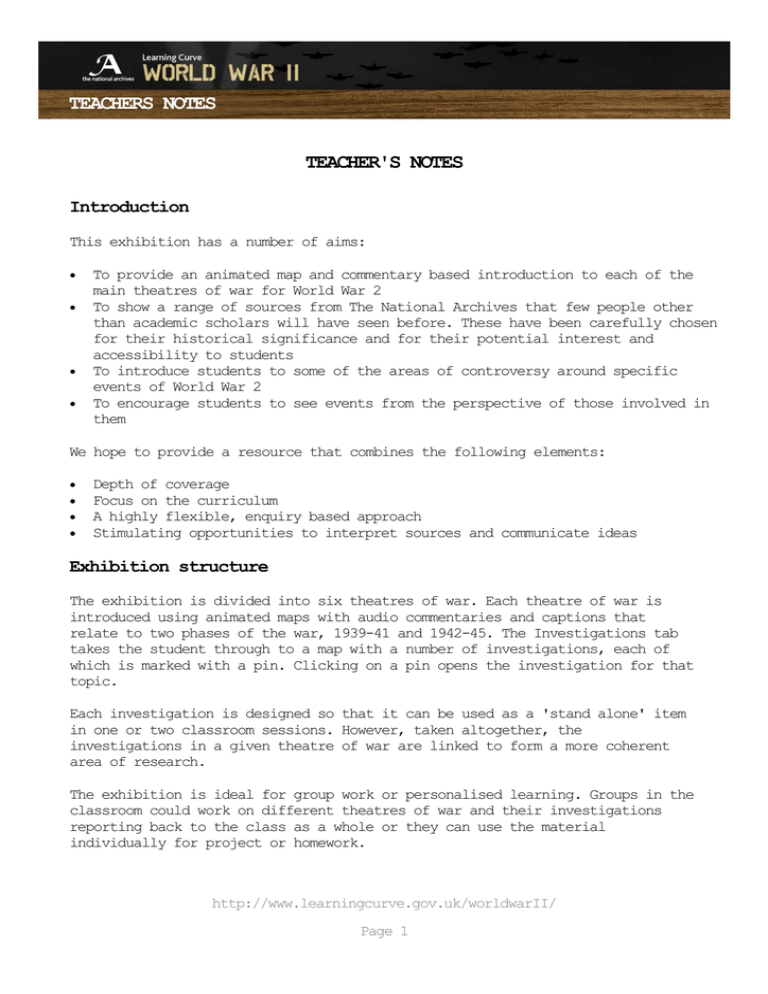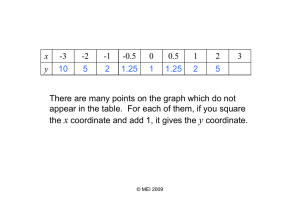TEACHERS NOTES TEACHER'S NOTES Introduction
advertisement

TEACHERS NOTES TEACHER'S NOTES Introduction This exhibition has a number of aims: • • • • To provide an animated map and commentary based introduction to each of the main theatres of war for World War 2 To show a range of sources from The National Archives that few people other than academic scholars will have seen before. These have been carefully chosen for their historical significance and for their potential interest and accessibility to students To introduce students to some of the areas of controversy around specific events of World War 2 To encourage students to see events from the perspective of those involved in them We hope to provide a resource that combines the following elements: • • • • Depth of coverage Focus on the curriculum A highly flexible, enquiry based approach Stimulating opportunities to interpret sources and communicate ideas Exhibition structure The exhibition is divided into six theatres of war. Each theatre of war is introduced using animated maps with audio commentaries and captions that relate to two phases of the war, 1939-41 and 1942-45. The Investigations tab takes the student through to a map with a number of investigations, each of which is marked with a pin. Clicking on a pin opens the investigation for that topic. Each investigation is designed so that it can be used as a 'stand alone' item in one or two classroom sessions. However, taken altogether, the investigations in a given theatre of war are linked to form a more coherent area of research. The exhibition is ideal for group work or personalised learning. Groups in the classroom could work on different theatres of war and their investigations reporting back to the class as a whole or they can use the material individually for project or homework. http://www.learningcurve.gov.uk/worldwarII/ Page 1 TEACHERS NOTES Lastly, the exhibition can be navigated in a different way from the homepage by going directly to the Index of Resources, which provides links to all the investigations in each theatre and all source files used within that investigation. The Index of Resources allows all the resources to be reached easily without having to go to a particular investigations map within a given theatre. Investigations structure Clicking on an investigation will reveal a box of sources. On the page there is a brief description of the task for a particular investigation. For more information pupils click on the link called Introduction: starter sources. This page details the task and provides an opening source that is significant for the investigation. Students can then "open" the source box for the investigation. This is a collection of different sources including: documents, maps, film, paintings or audio files. It is important to note that students can explore these sources in any order they chose after looking at the starter source. We have structured the exhibition in this non-linear way to give the students a real sense of working as a historian. In another words they have to sift through the evidence and decide the sequence of their investigation. This approach can also support a wider range of different learning styles and greater differentiation and flexibility. For example some students may prefer to start with a photograph or a watch a film clip before looking at a document that they may perceive as more difficult. Of course, teachers may wish to prompt their students to navigate the sources in a particular order by previously book-marking certain source pages. While some of the original sources used here are very accessible (images and simple documents), others are more challenging. To help with this we have provided all sources with audio transcripts and text transcripts as appropriate. We hope these features will provide further opportunities for differentiation when using the exhibition with mixed ability groups. The use of sound will also perhaps encourage pupils to engage more with the topic and help them to appreciate the differences in language, expression and ideas. There is also a global glossary for the site. All sources can be enlarged by clicking on them or by using the enlarge button on the web page. Some sources also have a zoomify feature so allow students to take a really close look at the evidence, notably the maps. This is where standard enlargement is not sufficient. http://www.learningcurve.gov.uk/worldwarII/ Page 2 TEACHERS NOTES Finally, all sources are supported by background information designed to give some context to the sources studied. There are questions to encourage students to interpret the original source. Downloadable worksheets, tables or presentation software templates are also available to help them record their ideas for the task at hand. Downloable pdfs are available for all investigations and individual sources. Curriculum This exhibition is intended for the history National Curriculum at Key Stage 3. KS3 Unit 18: Hot war, cold war: why did the major twentieth-century conflicts affect so many people? The unit focuses on the widespread impact of these conflicts through the examination of specific events, the personal experiences of individuals and a wide range of visual and written sources. The exhibition is also appropriate for the GCSE modern world history courses at Key stage 4 as examined by Edexcel, OCR and AQA. Theatres of war: Western Europe How worried was Britain about invasion 1940-41? Starter source: A cartoon produced by the British Ministry of Information in the early stages of the war. How did occupation affect peoples’ lives? Starter source: The British Ministry of Information drawing by Terence Cuneo. What was the role of Special Operations Executive and what kind of people worked for it? Starter source: Artists’ impressions of SOE agents in action. Why did Britain win the battle of the Battle of Britain? Starter source: Battle of Britain Monument. Did the British really employ magicians and practical jokers? Starter source: The plan involving the Himmler stamp. Why was D-Day successful? Starter source: Photographs of barrage balloons and boats departing and commandos landing in Normandy. http://www.learningcurve.gov.uk/worldwarII/ Page 3 TEACHERS NOTES Why did the RAF bomb cities? Starter source: Photographs that show the effects of Allied bombing on the German city of Hamburg, 1943. How might Churchill have replied to this telegram? Starter source: A telegram sent to Churchill in 1945 Eastern Europe How serious was the situation on the Eastern Front in 1942? Starter source: Photograph of the Russian front 1941-43. Should Stalingrad receive the George Cross? Starter source: Letter to Churchill from some girls in the Salop County Council typing office. Why didn’t Britain bomb the death camps? Starter source: Letter to Churchill from Polish woman living in Britain. How should we report the fall of Berlin? Starter source: Clip from a newsreel called Russians enter Berlin with a commentary in Russian, 1945. Mediterranean & North Africa What kind of man was Field Marshal Montgomery? Starter source: Notice sent out to all troops in the British Eighth Army, October 23rd 1942. Where are the Allies going to invade in 1943? Starter source: Photograph of Major Martin of the Royal Marines. Atlantic Can you raise the cash for the Atlantic museum? Starter source: A chart showing the attacks on an Atlantic convoy in August 1942. http://www.learningcurve.gov.uk/worldwarII/ Page 4 TEACHERS NOTES Asia Why was the fall of Singapore such a shock? Starter source: Photographs: British Empire forces in Singapore in late 1941. What should we remember about the ‘Forgotten Army’? Starter source: Photo of women on the Burma front. Pacific Why was the USA so unprepared for the attack on Pearl Harbor in 1941? Starter source: British newsreel from January 1942 Pearl Harbour – First Pictures. Why was the battle for Iwo Jima so important to America? Starter source: Photograph of US Marines raising the American flag on the island of Iwo Jima in 1945. Was Hiroshima the biggest event of World War 2? Starter source: Part of an American newsreel about the dropping of the Atomic Bomb on Hiroshima in August 1945. http://www.learningcurve.gov.uk/worldwarII/ Page 5







